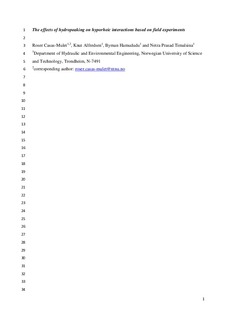| dc.contributor.author | Casas-Mulet, Roser | |
| dc.contributor.author | Alfredsen, Knut | |
| dc.contributor.author | Hamududu, Byman Hikanyona | |
| dc.contributor.author | Timalsina, Netra Prasad | |
| dc.date.accessioned | 2018-03-08T14:50:38Z | |
| dc.date.available | 2018-03-08T14:50:38Z | |
| dc.date.created | 2014-06-08T23:47:13Z | |
| dc.date.issued | 2015 | |
| dc.identifier.citation | Hydrological Processes. 2015, 29 (6), 1370-1384. | nb_NO |
| dc.identifier.issn | 0885-6087 | |
| dc.identifier.uri | http://hdl.handle.net/11250/2489566 | |
| dc.description.abstract | Hydropeaking power production has the potential to pose serious challenges towards hydrology, water quality and ecology in the downstream water bodies. The effects of such abrupt changes of flow in hyporheic exchange have been explored in a few cases in the literature. This paper extends previous works with a study of finer time resolution in a river of a smaller size and with different climatic characteristics, adding to the current knowledge of peaking-hyporheic interactions. A high-frequency logging field experiment measuring hyporheic flow and temperature was conducted on a ~30 × 20 m gravel bar frequently exposed to dry conditions because of fast and abrupt flow changes. This study demonstrates that hyporheic processes are sensitive to hydropeaking with respect to rates of change, durations and temperature. Differences BETWEEN individual events, seasons, watering and dewatering processes and positions in the river bed that can be potentially relevant to ecology were investigated. Understanding the complexity of those processes at the fine scale from the physical point of view is both important for the judgement of potential ecological impacts and for the future management of such regulated systems. | nb_NO |
| dc.language.iso | eng | nb_NO |
| dc.publisher | Wiley | nb_NO |
| dc.title | The effects of hydropeaking on hyporheic interactions based on field experiments | nb_NO |
| dc.type | Journal article | nb_NO |
| dc.type | Peer reviewed | nb_NO |
| dc.description.version | acceptedVersion | nb_NO |
| dc.source.pagenumber | 1370-1384 | nb_NO |
| dc.source.volume | 29 | nb_NO |
| dc.source.journal | Hydrological Processes | nb_NO |
| dc.source.issue | 6 | nb_NO |
| dc.identifier.doi | 10.1002/hyp.10264 | |
| dc.identifier.cristin | 1137129 | |
| dc.relation.project | Norges forskningsråd: 193818 | nb_NO |
| dc.description.localcode | This is the peer reviewed version of the following article: [The effects of hydropeaking on hyporheic interactions based on field experiments], which has been published in final form at [http://onlinelibrary.wiley.com/doi/10.1002/hyp.10264/abstract;jsessionid=F4CFE351611EB7E725CE2C001FE7B8E8.f04t04]. This article may be used for non-commercial purposes in accordance with Wiley Terms and Conditions for Self-Archiving. | nb_NO |
| cristin.unitcode | 194,64,91,0 | |
| cristin.unitname | Institutt for bygg- og miljøteknikk | |
| cristin.ispublished | true | |
| cristin.fulltext | postprint | |
| cristin.qualitycode | 1 | |
